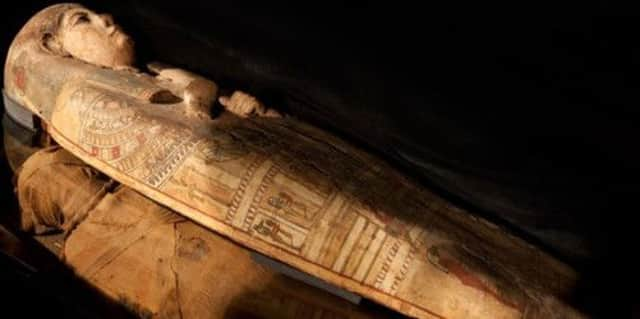CT scan to solve mystery of Perth Museum mummy


Perth Museum’s ancient Egyptian mummy, believed to contain the remains of a priestess or a princess from Thebes on the banks of the Nile, has been one of the most popular museum exhibits since the historic mummy first went on show in the 1930s after being transferred from the former Alloa Museum.
Until now, the mummified remains inside the ornate sarcophagus have been shrouded in mystery. But today the mummy will start a journey from Scotland to Northern England where experts at the Manchester - based KINH Centre for Biomedical Egyptology will finally begin unlocking the secrets of the ancient mummy at a children’s hospital in the city.
Advertisement
Hide AdAdvertisement
Hide AdAs part of the Ancient Egyptian Animal Bio Bank project at the KNH Centre at Manchester University, the mummy is being shipped to the Royal Manchester Children’s Hospital where it will undergo both a conventional x-ray and a CT scan for the very first time.
And the experts hope their investigations will begin to uncover details about the mummy’s life and death.
Dr Lidija McKnight, from the Ancient Egyptian Animal Bio Bank project, explained: “Non-destructive scientific techniques will be used to study the human mummy in the Perth Museum collection enabling us to better understand how the individual lived and died, including how the body was treated by the embalmers, whilst causing no damage to the mummy itself.”
Mummy’s gender
She continued: “This is an extraordinary opportunity to X-ray a mummy which has never been studied before, making us the first people to see inside the wrappings since the body was mummified thousands of years ago.
“We hope that by combining modern science and the expertise of the Bio Bank team at the University of Manchester, the Perth mummy will be better understood, promoted and conserved.”
Dr McKnight said: “We know the coffin suggests it’s a female, so we will check whether it really is a woman. If it’s a man, then clearly something has gone awry at some stage over the years.
“We’ll try and assess an age - was this an adult, a teenager, or a child? And we should get some suggestion of whether the person had suffered any diseases or injures.
“And are there any amulets or jewellery incorporated within the bandages? We won’t know until we have a look.”
Advertisement
Hide AdAdvertisement
Hide AdShe added: “We will also look to see how the body was mummified. Were internal organs left in, taken out altogether, or taken out and wrapped and then put back? “Was the brain removed? That may depend on the period in which the body was mummified.”
A spokesman for Manchester University said: “Perth Museum’s 3,000 year old Egyptian mummy has been one of the most popular museum exhibits since she arrived from Alloa Museum in the 1930s. Believed to be either a priestess or a princess from Thebes, the mystery surrounding her life story has kept visitors guessing for years.
He explained that museum collection transport specialists, Constantine, were arriving at Perth Museum today to carefully pack the mummy in to a custom built case and ensure that her journey to Manchester is a smooth one.
The spokesman continued: “ She will be accompanied by the Museum’s History Officer, Mark Hall, who is eager to see the results of the scan. The mummy will return to Perth Museum on 7 June.
“The funding necessary to transport the mummy to Manchester was provided by the Faculty of Life Sciences, University of Manchester, and made possible through collaboration with the Central Manchester University Teaching Hospitals NHS Foundation Trust.”